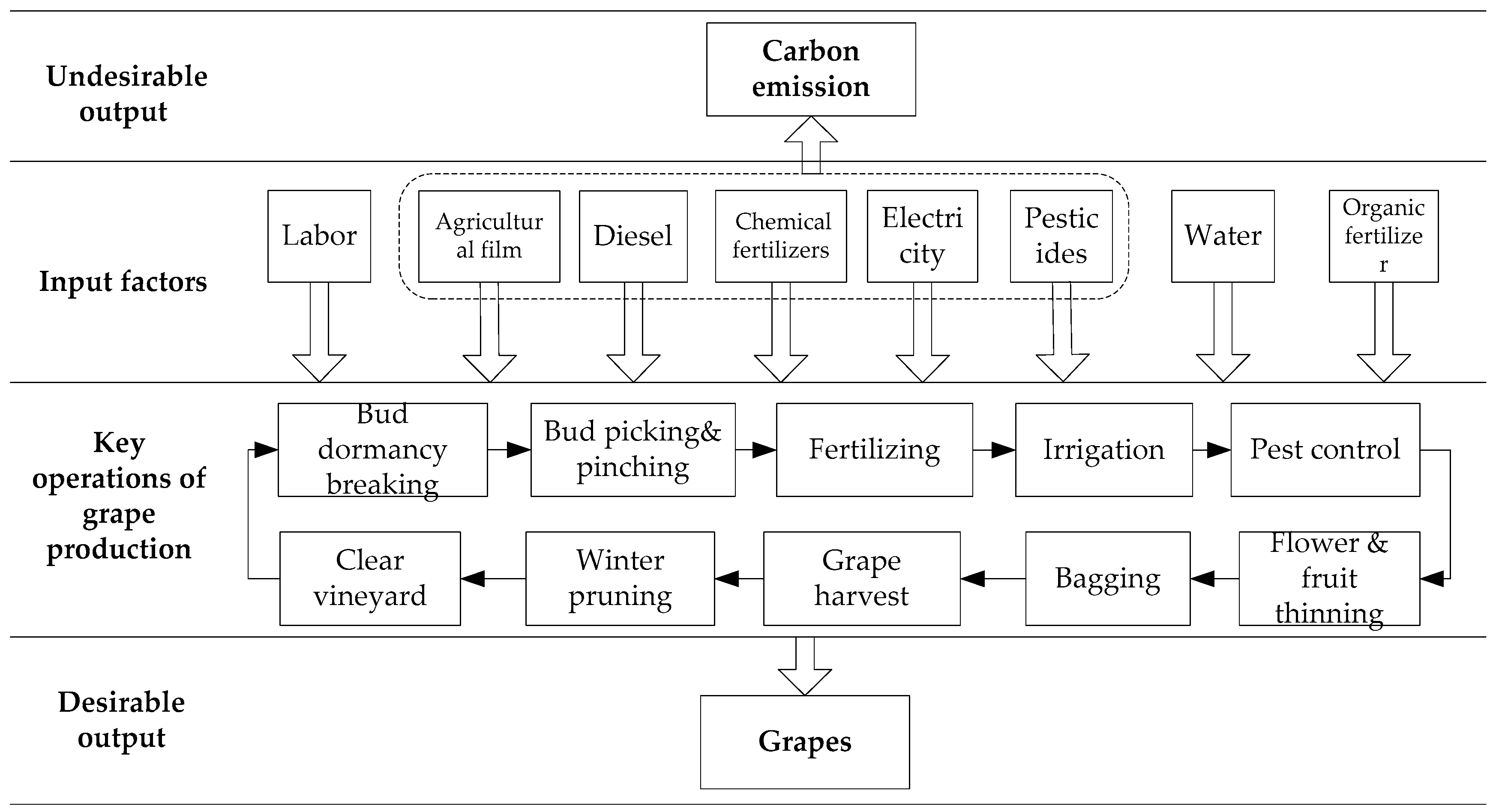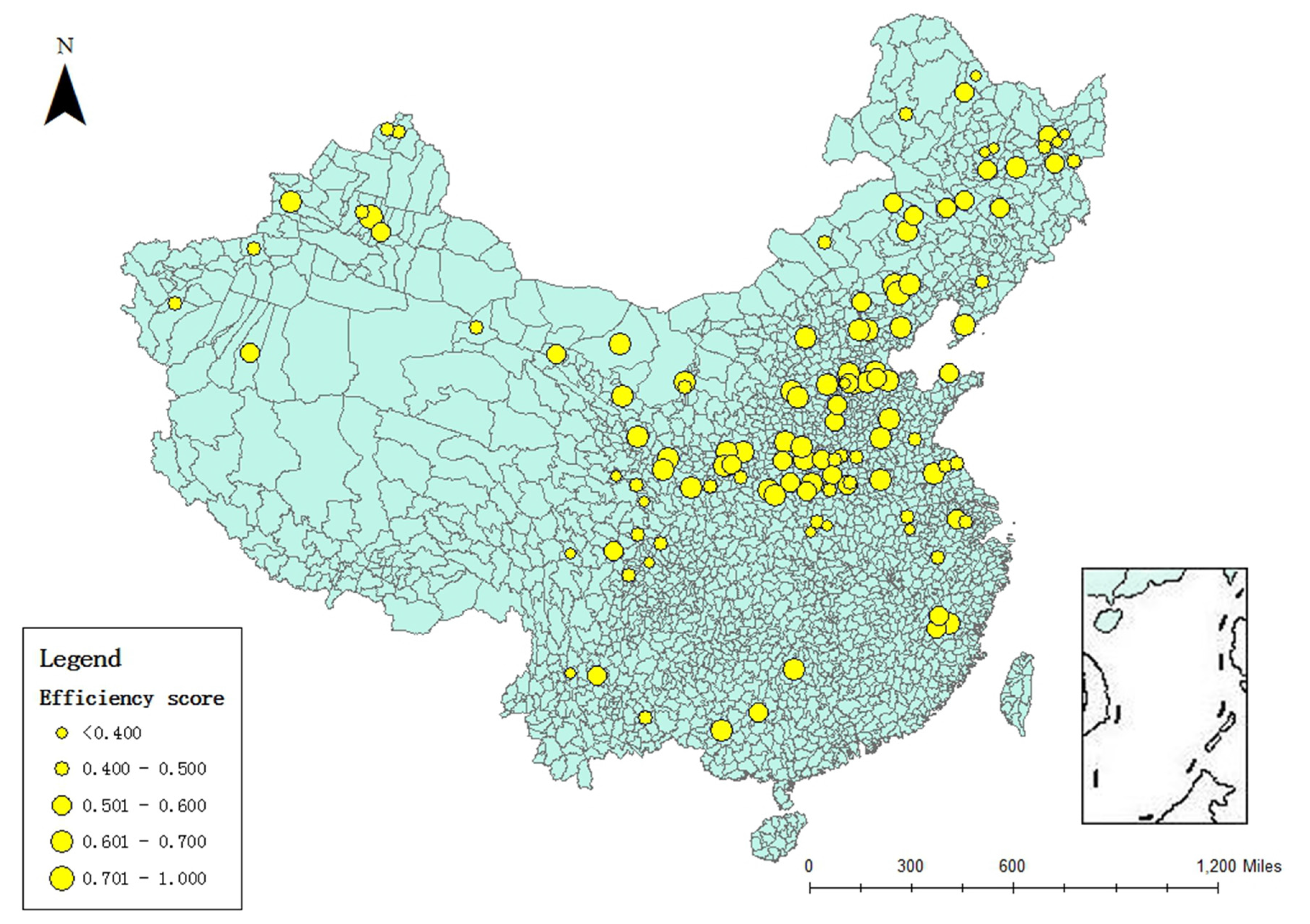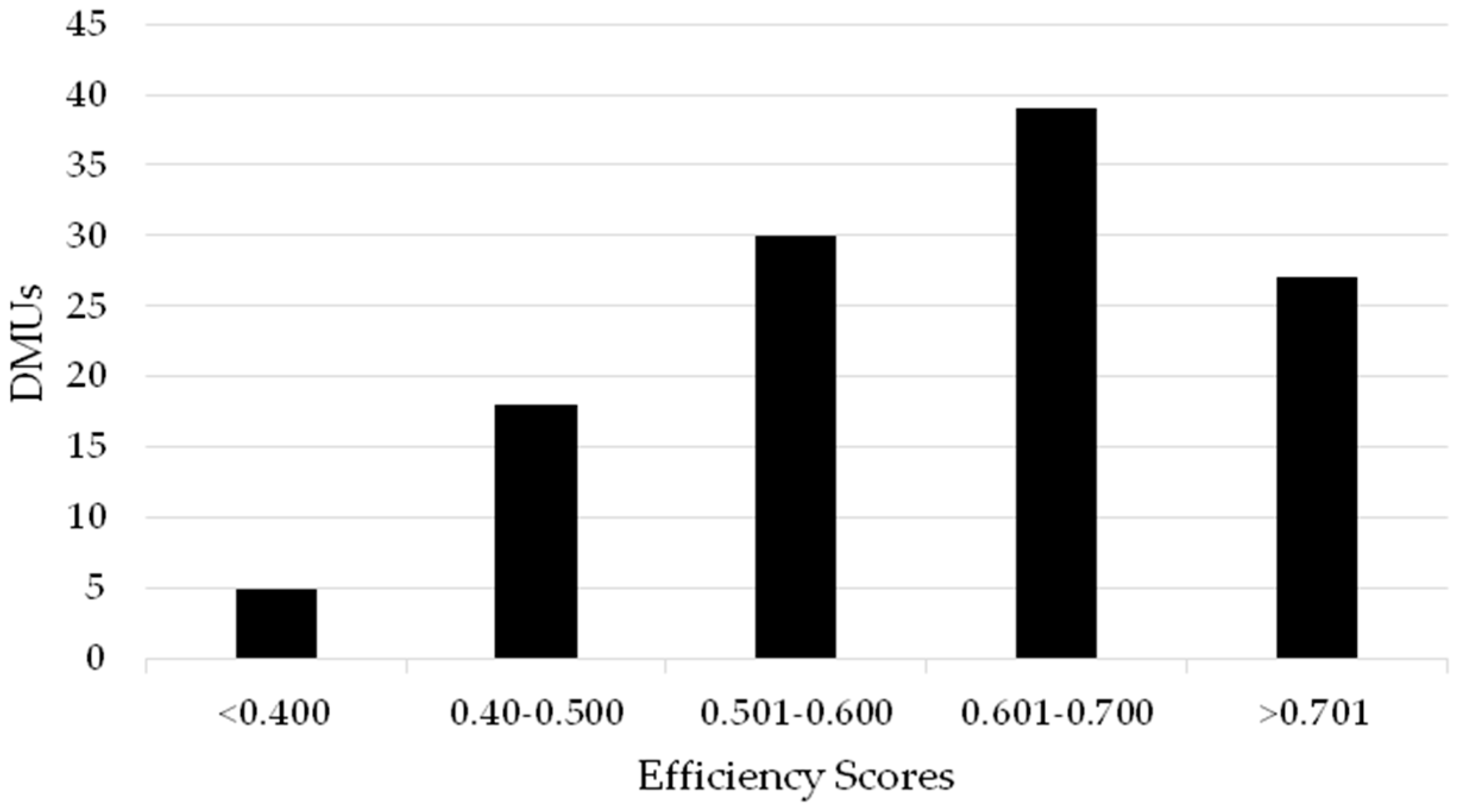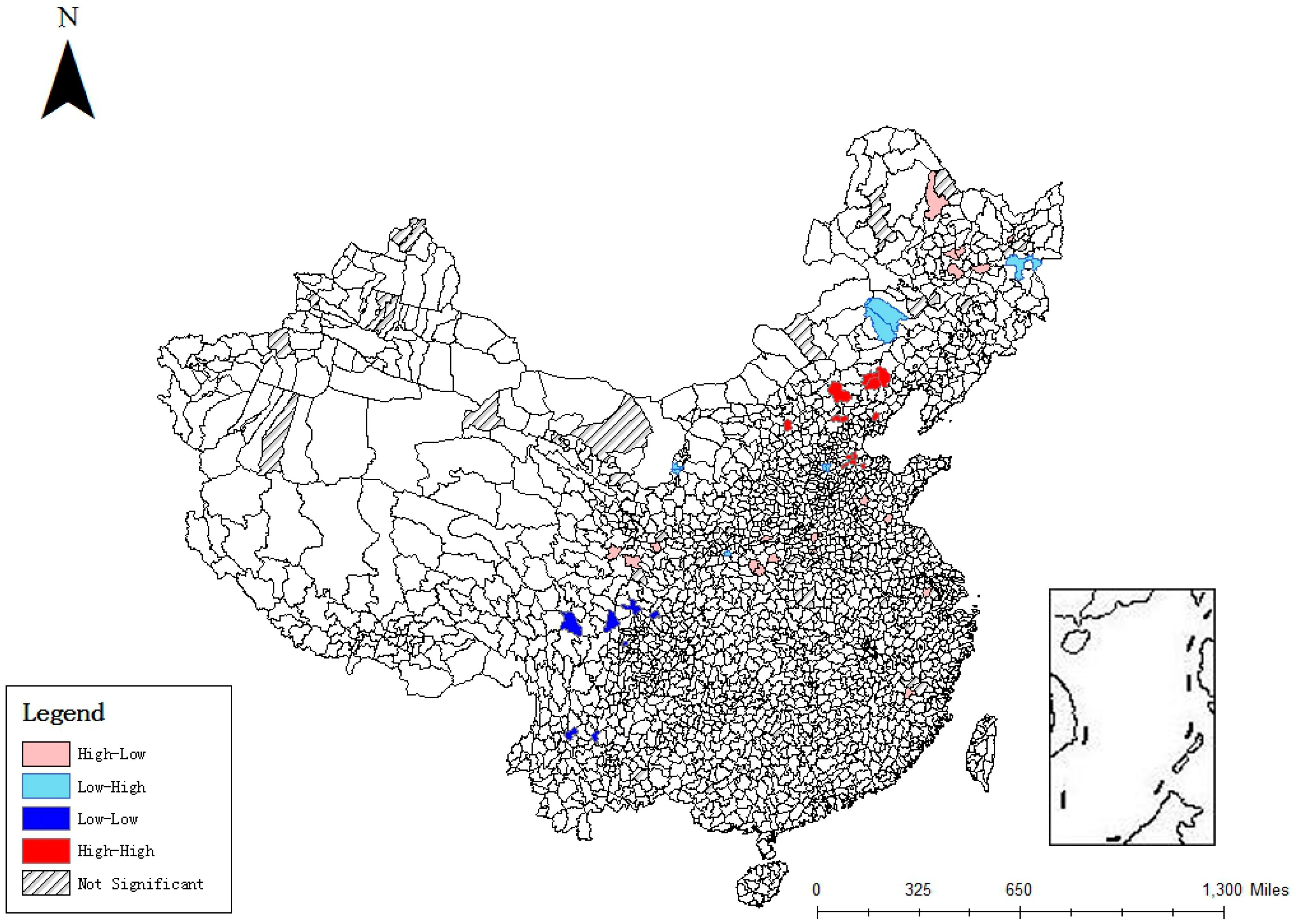Environmental Efficiency of Chinese Open-Field Grape Production: An Evaluation Using Data Envelopment Analysis and Spatial Autocorrelation
Abstract
:1. Introduction
2. Materials and Methods
2.1.Data Collection
2.2. Environmental Efficiency Analysis Based on Carbon Emission Calculation in the Production System
2.2.1. Open-Field Grape Production System Analysis with the Constraint of Carbon Emissions
2.2.2. Carbon Emission Calculation Method
- Direct carbon emissions include the carbon emissions from fossil energy consumption in the production process of grape, such as diesel, and so on;
- Indirect carbon emissions are carbon emissions from the production of the agricultural inputs, such as electricity, pesticides, and so on.
2.3. Evaluation Model of Environmental Efficiency
2.4. Spatial Autocorrelation Model
2.4.1. The Global Autocorrelation Model of the Environmental Efficiency
2.4.2. Local Autocorrelation Analysis of the Environmental Efficiency
3. Results
3.1. Environmental Efficiency Evaluation
3.2. Global Spatial Correlation Analysis
3.3. Local Spatial Correlation Analysis
4. Discussion
5. Conclusions
Acknowledgments
Author Contributions
Conflicts of Interest
References
- Schandl, H.; Hatfield-Dodds, S.; Wiedmann, T. Decoupling global environmental pressure and economic growth: Scenarios for energy use, materials use and carbon emissions. J. Clean. Prod. 2015, 30, 49–50. [Google Scholar] [CrossRef]
- Change, C. Intergovernmental Panel on Climate Change; World Meteorological Organization: Geneva, Switzerland, 2007. [Google Scholar]
- CARS-30, Chinese Agricultural Research System-Grape Industry. Available online: http://119.253.58.231 (accessed on 13 October 2016).
- Ozkan, B.; Fert, C.; Karadeniz, C.F. Energy and cost analysis for greenhouse and open-field grape production. Energy 2007, 32, 1500–1504. [Google Scholar] [CrossRef]
- Nadia, M.; Margherita, P.; Valentina, N. Sustainability indicators for environmental performance and sustainability assessment of the productions of four fine Italian wines. Int. J. Sustain. Dev. World Ecol. 2003, 10, 275–282. [Google Scholar]
- Steenwerth, K.L.; Strong, E.B.; Greenhut, R.F. Life cycle greenhouse gas, energy, and water assessment of wine grape production in California. Int. J. Life Cycle Assess. 2015, 20, 1243–1253. [Google Scholar] [CrossRef]
- Si, J.T.; Li, D.; Liu, J.W. Study on Methodologies Used to Assess Hazardous Waste Treatment and Management Technologies. Res. Environ. Sci. 2005, 18, 39–42. [Google Scholar]
- Diego, I.; Almudena, H.; María, T.M. Benchmarking environmental and operational parameters through eco-efficiency criteria for dairy farms. Sci. Total Environ. 2011, 409, 1786–1798. [Google Scholar]
- Notarnicola, B.; Tassielli, G.; Renzulli, P.A. Environmental and technical improvement of a grape must concentration system via a life cycle approach. J. Clean. Prod. 2014, 89, 87–98. [Google Scholar] [CrossRef]
- Fuchsz, M.; Kohlheb, N. Comparison of the environmental effects of manure- and crop-based agricultural biogas plants using life cycle analysis. J. Clean. Prod. 2015, 86, 60–66. [Google Scholar] [CrossRef]
- Parker, P. An Environmental Measure of Japan’s Economic Development: The Ecological Footprint. Geogr. Z. 1998, 86, 106–119. [Google Scholar]
- Jorgenson, A.K. Consumption and Environmental Degradation: A Cross-National Analysis of the Ecological Footprint. Soc. Probl. 2003, 50, 374–394. [Google Scholar] [CrossRef]
- Blasi, E.; Passeri, N.; Franco, S. An ecological footprint approach to environmental-economic evaluation of farm results. Agric. Syst. 2016, 145, 76–82. [Google Scholar] [CrossRef]
- Carolyn, H.; Richard, O.; Daniel, M. Material Flow Analysis: A tool to support environmental policy decision making. Case-studies on the city of Vienna and the Swiss lowlands. Local Environ. 2000, 5, 311–328. [Google Scholar]
- Kotani, K.; Masunaga, S. Environmental impact assessment of chlorine in liquid crystal display glass (LCDG) based on material flow analysis. J. Environ. Manag. 2012, 112, 304–308. [Google Scholar] [CrossRef] [PubMed]
- Montanari, R. Environmental efficiency analysis for enel thermo-power plants. J. Clean. Prod. 2004, 12, 403–414. [Google Scholar] [CrossRef]
- Semenyutina, A.V.; Podkovyrov, I.U.; Semenyutina, V.A. Environmental efficiency of the cluster method of analysis of greenery objects decorative advantages. Life Sci. J. 2014, 11, 699–701. [Google Scholar]
- Reinhard, S.; Lovell, C.; Thijssen, G.J. Environmental efficiency with multiple environmentally detrimental variables; estimated with SFA and DEA. Eur. J. Oper. Res. 2000, 121, 287–303. [Google Scholar] [CrossRef]
- Power, B.; Cacho, O.J. Identifying risk-efficient strategies using stochastic frontier analysis and simulation: An application to irrigated cropping in Australia. Agric. Syst. 2014, 125, 23–32. [Google Scholar] [CrossRef]
- Waryanto, B.; Chozin, M.A.; Dadang. Environmental Efficiency Analysis of Shallot Farming: A Stochastic Frontier Translog Regression Approach. J. Biol. Agric. Healthc. 2014, 19, 87–100. [Google Scholar]
- Katharakis, G.; Katharaki, M.; Katostaras, T. An empirical study of comparing DEA and SFA methods to measure hospital units’ efficiency. Int. J. Oper. Res. 2014, 21, 242–251. [Google Scholar] [CrossRef]
- Vencheh, A.H.; Matin, R.K.; Kajani, M.T. Undesirable factors in efficiency measurement. Appl. Math. Comput. 2005, 163, 547–552. [Google Scholar] [CrossRef]
- Sueyoshi, T.; Goto, M. DEA radial measurement for environmental assessment: A comparative study between Japanese chemical and pharmaceutical firms. Appl. Energy 2014, 115, 502–513. [Google Scholar] [CrossRef]
- Halkos, G.E.; Tzeremes, N.G. Measuring the effect of Kyoto protocol agreement on countries’ environmental efficiency in CO2 emissions: An application of conditional full frontiers. J. Prod. Anal. 2014, 41, 367–382. [Google Scholar] [CrossRef]
- Skevas, T.; Stefanou, S.E.; Lansink, A.O. Pesticide use, environmental spillovers and efficiency: A DEA risk-adjusted efficiency approach applied to Dutch arable farming. Eur. J. Oper. Res. 2014, 237, 658–664. [Google Scholar] [CrossRef]
- Vlontzos, G.; Niavis, S.; Manos, B. A DEA approach for estimating the agricultural energy and environmental efficiency of EU countries. Renew. Sustain. Energy Rev. 2014, 40, 91–96. [Google Scholar] [CrossRef]
- Valadkhani, A.; Roshdi, I.; Smyth, R. A multiplicative environmental DEA approach to measure efficiency changes in the world’s major polluters. Energy Econ. 2016, 54, 363–375. [Google Scholar] [CrossRef]
- Wang, X.; Huang, G. Impacts assessment of air emissions from point sources in Saskatchewan, Canada—A spatial analysis approach. Environ. Prog. Sustain. Energy 2014, 34, 1–10. [Google Scholar] [CrossRef]
- Camarero, M.; Picazo-Tadeo, A.J.; Tamarit, C. Is the environmental performance of industrialized countries converging? A ‘SURE’ approach to testing for convergence. Ecol. Econ. 2008, 66, 653–661. [Google Scholar] [CrossRef]
- Marconi, V.; Raggi, M.; Viaggi, D. Assessing the impact of RDP agri-environment measures on the use of nitrogen-based mineral fertilizers through spatial econometrics: The case study of Emilia-Romagna (Italy). Ecol. Indic. 2015, 59, 27–40. [Google Scholar] [CrossRef]
- Costantini, V.; Mazzanti, M.; Montini, A. Environmental performance, innovation and spillovers. Evidence from a regional NAMEA. Ecol. Econ. 2013, 89, 101–114. [Google Scholar] [CrossRef]
- Adetutu, M.; Glass, A.J.; Kenjegalieva, K. The effects of efficiency and TFP growth on pollution in Europe: A multistage spatial analysis. J. Prod. Anal. 2015, 43, 307–326. [Google Scholar] [CrossRef]
- Shen, N.; Wang, Q.W. Environmental Efficiency Evaluation and Spatial Effect Taking Account of Technology Heterogeneity. J. Ind. Eng. Eng. Manag. 2015, 29, 162–168. [Google Scholar]
- Zhao, D.L. Empirical Research on the Evaluation and Spatial Correlation of Industrial Environmental Efficiency in China. Master’s Thesis, Beijing Forestry University, Beijing, China, 2015. [Google Scholar]
- Wu, J.; Zhu, Q.; Chu, J. Measuring energy and environmental efficiency of transportation systems in China based on a parallel DEA approach. Transp. Res. Part D Transp. Environ. 2016, 48, 460–472. [Google Scholar] [CrossRef]
- Wang, H.B.; Wang, X.D.; Wang, B.L. Present situation, problems and Development Countermeasures of grape industry in northern China. Agric. Eng. Technol. (Greenh. Hortic.) 2011, 1, 21–24. [Google Scholar]
- Wei, T.; Lujia, Y.; Jing, J. Research on Chinese agricultural eco-efficiency based on SBM model of undesirable outputs. China Rural Surv. 2014, 5, 59–71. [Google Scholar]
- West, T.O.; Marland, G. A synthesis of carbon sequestration, carbon emissions, and net carbon flux in agriculture: Comparing tillage practices in the United States. Agric. Ecosyst. Environ. 2002, 91, 217–232. [Google Scholar] [CrossRef]
- Lal, R. Carbon emission from farm operations. Environ. Int. 2004, 30, 981–990. [Google Scholar] [CrossRef] [PubMed]
- Dyer, J.A.; Desjardins, R.L. Simulated farm fieldwork, energy consumption and related greenhouse gas emissions in Canada. Biosyst. Eng. 2003, 85, 503–513. [Google Scholar] [CrossRef]
- Pishgar-Komleh, S.H.; Ghahderijani, M.; Sefeedpari, P. Energy consumption and CO2 emissions analysis of potato production based on different farm size levels in Iran. J. Clean. Prod. 2012, 33, 183–191. [Google Scholar] [CrossRef]
- Lampe, H.W.; Hilgers, D. Trajectories of efficiency measurement: A bibliometric analysis of DEA and SFA. Eur. J. Oper. Res. 2015, 240, 1–21. [Google Scholar] [CrossRef]
- Martínez, C.I.P. Estimating and Analyzing Energy Efficiency in German and Colombian Manufacturing Industries Using DEA and Data Panel Analysis. Part I: Energy-intensive Sectors. Energy Sources Part B Econ. Plan. Policy 2015, 10, 322–331. [Google Scholar] [CrossRef]
- Saati, S.; Memariani, A. SBM model with fuzzy input-output levels in DEA. Aust. J. Basic Appl. Sci. 2009, 3, 352–357. [Google Scholar]
- Tone, K. A slacks-based measure of efficiency in data envelopment analysis. Eur. J. Oper. Res. 2001, 130, 498–509. [Google Scholar] [CrossRef]
- Zheng, J.; Liu, X.; Bigsten, A. Ownership structure and determinants of technical efficiency: An application of data envelopment analysis to Chinese enterprises (1986–1990). J. Comp. Econ. 1998, 26, 465–484. [Google Scholar] [CrossRef]
- Diniz-Filho, J.A.F.; Bini, L.M.; Hawkins, B.A. Spatial autocorrelation and red herrings in geographical ecology. Glob. Ecol. Biogeogr. 2003, 12, 53–64. [Google Scholar] [CrossRef]
- LeSage, J.P. An introduction to spatial econometrics. Revue D’économie Industrielle 2008, 123, 19–44. [Google Scholar] [CrossRef]
- Aldstadt, J.; Getis, A. Using AMOEBA to Create a Spatial Weights Matrix and Identify Spatial Clusters. Geogr. Anal. 2006, 38, 327–343. [Google Scholar] [CrossRef]
- Anselin, L. Local Indicators of Spatial Association—LISA. Geogr. Anal. 1995, 27, 93–115. [Google Scholar] [CrossRef]
- Mu, W.; Yan, Z.; Gavrila, S.P. A Full Carbon Cycle Comparative Analysis in Greenhouse and Open-Field Grape Cultivation. J. Environ. Prot. Ecol. 2015, 16, 461–469. [Google Scholar]
- Ma, C.Y.; Mu, W.S. Assessing the technical efficiency of grape production in open field cultivation in China. J. Food Agric. Environ. 2012, 10, 345–349. [Google Scholar]




| Sources | Carbon Emission Coefficient | Reference |
|---|---|---|
| Chemical Fertilizer | 0.8956 Kg·Kg−1 | West et al. [38] |
| Pesticides | 5.10 Kg·Kg−1 | Lal et al. [39] |
| Agricultural Film | 5.18 Kg·Kg−1 | Institute of Resource, Ecosystem and Environment of Agriculture of Nanjing city |
| Diesel | 2.76 Kg·L−1 | Dyer et al. [40] |
| Electricity | 0.608 Kg·kWh−1 | Pishgar-Komleh et al. [41] |
| Input/Output | Variable | Units |
|---|---|---|
| Input | Labor | (labor·day)/ha./year |
| Agricultural film | Kg/ha./year | |
| Diesel | Kg/ha./year | |
| Chemical fertilizers | Kg/ha./year | |
| Electricity | kWh/ha./year | |
| Pesticides | Kg/ha./year | |
| Water | Kg/ha./year | |
| Organic fertilizer | Kg/ha./year | |
| Desirable output | Grapes | Kg/ha./year |
| Undesirable output | Carbon emission | Kg/ha./year |
| Areas | AES | S.D. | Regions | AES |
|---|---|---|---|---|
| North China | 0.714 | 0.121 | Beijing | 0.779 |
| Shanxi | 0.689 | |||
| Shandong | 0.684 | |||
| Henan | 0.679 | |||
| Hebei | 0.772 | |||
| Inner Mongolia | 0.681 | |||
| Southwest China | 0.528 | 0.163 | Sichuan | 0.483 |
| Yunnan | 0.573 | |||
| Northeast China | 0.626 | 0.158 | Heilongjiang | 0.564 |
| Liaoning | 0.679 | |||
| Jilin | 0.635 | |||
| South China | 0.618 | 0.179 | Jiangsu | 0.646 |
| Hubei | 0.518 | |||
| Anhui | 0.669 | |||
| Fujian | 0.585 | |||
| Guangxi | 0.673 | |||
| Northwest China | 0.679 | 0.023 | Gansu | 0.690 |
| Xinjiang | 0.695 | |||
| Shanxi | 0.682 | |||
| Ningxia | 0.650 |
| Year | Moran’s I | p-Value | Z-Value |
|---|---|---|---|
| 2014 | 0.329 | 0.001 | 5.784 |
© 2016 by the authors; licensee MDPI, Basel, Switzerland. This article is an open access article distributed under the terms and conditions of the Creative Commons Attribution (CC-BY) license (http://creativecommons.org/licenses/by/4.0/).
Share and Cite
Tian, D.; Zhao, F.; Mu, W.; Kanianska, R.; Feng, J. Environmental Efficiency of Chinese Open-Field Grape Production: An Evaluation Using Data Envelopment Analysis and Spatial Autocorrelation. Sustainability 2016, 8, 1246. https://doi.org/10.3390/su8121246
Tian D, Zhao F, Mu W, Kanianska R, Feng J. Environmental Efficiency of Chinese Open-Field Grape Production: An Evaluation Using Data Envelopment Analysis and Spatial Autocorrelation. Sustainability. 2016; 8(12):1246. https://doi.org/10.3390/su8121246
Chicago/Turabian StyleTian, Dong, Fengtao Zhao, Weisong Mu, Radoslava Kanianska, and Jianying Feng. 2016. "Environmental Efficiency of Chinese Open-Field Grape Production: An Evaluation Using Data Envelopment Analysis and Spatial Autocorrelation" Sustainability 8, no. 12: 1246. https://doi.org/10.3390/su8121246
APA StyleTian, D., Zhao, F., Mu, W., Kanianska, R., & Feng, J. (2016). Environmental Efficiency of Chinese Open-Field Grape Production: An Evaluation Using Data Envelopment Analysis and Spatial Autocorrelation. Sustainability, 8(12), 1246. https://doi.org/10.3390/su8121246





